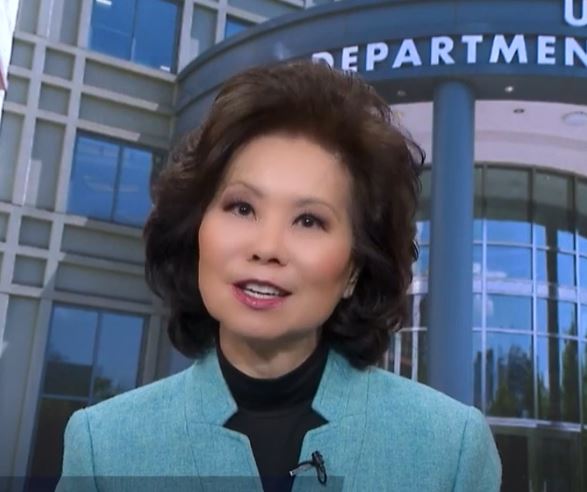U.S. updates HoS rules, offering more flexibility to drivers
WASHINGTON, D.C. – After analyzing feedback received over the past two years, the U.S. Federal Motor Carrier Safety Administration has updated the Hours-of-Service (HoS) rules that officials say will offer more flexibility to drivers and increase safety on America’s roadways.

“This new final rule will improve safety for all motorists and increase flexibility for America’s truckers,” Secretary of Transportation Elaine L. Chao told a news conference Thursday.
“It has been guided by the feedback that we have received from truckers, carrier safety advocates, law enforcement and also concerned residents and citizens.”
In all, the department received more than 8,000 public comments, Chao said.
Key revisions:
- The agency will increase safety and flexibility for the 30-minute break rule by requiring a break after 8 hours of consecutive driving and allowing the break to be satisfied by a driver using on-duty, not driving status, rather than off-duty status.
- The agency will modify the sleeper-berth exception to allow drivers to split their required 10 hours off duty into two periods: an 8/2 split, or a 7/3 split — with neither period counting against the driver’s 14 hour driving window.
- The agency will modify the adverse driving conditions exception by extending by two hours the maximum window during which driving is permitted.
- The agency will change the short-haul exception available to certain commercial drivers by lengthening the drivers’ maximum on-duty period from 12 to 14 hours and extending the distance limit within which the driver may operate from 100 air miles to 150 air miles.
No increase in driving time
Acting FMCSA Administrator Jim Mullen stressed that the rule changes do not increase driving time, and will continue to prevent operators from driving for more than eight consecutive hours without at least a 30-minute break.
The new rule will have an implementation date of 120 days after publication in the Federal Register.
The agency said it will lead to an annualized cost saving of nearly $274 million for the U.S. economy and American consumers.
Both Chao and Mullen praised the “tremendous contribution” the truck drivers are making during Covid-19.
“Truckers are really American heroes, especially at a time like this,” said Chao.
ATA welcomes changes
The American Trucking Associations quickly welcomed the changes, saying it had been engaged in the rulemaking process from the very beginning.
“Today’s rule is the result of a two-year, data-driven process and it will result in needed flexibility for America’s professional truck drivers while maintaining the safety of our roads,” said ATA president and CEO Chris Spear.
Teamsters not happy
Teamsters sharply criticized the revised rules, saying they would lead to reduced roadway safety.
For example, the union said, short-haul truckers would be able to drive for 14 hours, instead of the current 12.
“In an effort to increase so-called ‘flexibility’ for trucking companies, the FMCSA is abandoning safety and allowing drivers to push themselves to the limit even further,” Teamsters president Jim Hoffa said.
The U.S. trucking industry employs more than 7 million people and moves 70% of the country’s domestic freight.
- This story has been updated with comments from Teamsters.
Have your say
This is a moderated forum. Comments will no longer be published unless they are accompanied by a first and last name and a verifiable email address. (Today's Trucking will not publish or share the email address.) Profane language and content deemed to be libelous, racist, or threatening in nature will not be published under any circumstances.
-
No one says you HAVE to drive 14 straight hours… If you need a nap, you take a nap, PERIOD!
HI.
im truck driver for over 10 years, and i drive with team driver maybe with abut 60 drivers. and i have experience abut every driver i mean human power driving control. 99% of the drivers can drive 8 hours with no problem at all , after 8 hours the 99% of the drivers losing there control driving abut 70% from there power driving control .
1- team drivers can drive only 8 hours with 30 minutes break on there driving time .
2- solo driver can drive 7-8 hours and sleep 5-6 hours and drive 7-8 hours after thees hours driving the driver must sleep 10 hours, to start over driving 7-8 hours and sleep 5-6 hours and drive 7-8 hours. this program well make safety driving up to 90% batter thin how it is now only 50% safety driving.
and i with for some body to understand driver is human not only worker, its my idea im human driver and i like to help my brothers all drivers, good bless
best regards
The 14 hour rule is stupid. It makes you drive when your tired and need a nap. The people making these rules has never drove a truck and probably never even sat in one. These rules are getting ignorant people killed because their company has to drive so may miles a day, if they don’t they loss their job. Now while covid is going on, y’all pulled the hours of service because everyone was in need, but when it’s over we go back to the normal bull. What’s the difference. LMAO. It’s not about safety, it’s about money and control, plain and simple. I’ve had license to drive a truck for 32 year’s, never been charged with an accident. Wonder how I did that with out elog.